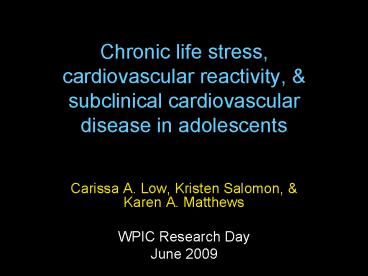Chronic life stress, cardiovascular reactivity, - PowerPoint PPT Presentation
1 / 23
Title:
Chronic life stress, cardiovascular reactivity,
Description:
Atherosclerosis begins in childhood ... Subclinical atherosclerosis. B-mode ultrasound to measure carotid intima-media thickness (IMT) Carotid Atherosclerosis ... – PowerPoint PPT presentation
Number of Views:61
Avg rating:3.0/5.0
Title: Chronic life stress, cardiovascular reactivity,
1
Chronic life stress, cardiovascular reactivity,
subclinical cardiovascular disease in adolescents
- Carissa A. Low, Kristen Salomon, Karen A.
Matthews - WPIC Research Day
- June 2009
2
Cardiovascular health of adolescents
- Atherosclerosis begins in childhood
- Noninvasive imaging techniques permit examination
of subclinical atherosclerosis in healthy
adolescents
3
Chronic stress andcardiovascular disease (CVD)
- Chronic psychological stress is a risk factor for
CVD in some but not all studies - Studies that assess stress only once may not
adequately capture chronic stress
4
Acute stress reactivity and CVD
- Cardiovascular reactivity to acute stress
implicated as a mechanism linking psychological
stress to CVD - Most studies include a single assessment of
cardiovascular reactivity, and changes in
reactivity rarely examined
5
Whats missing
- Studies that include repeated assessments of
chronic stress or cardiovascular reactivity, to
examine the effects of increasing stress or
reactivity on CVD - Studies that examine the relationships between
chronic stress, acute reactivity, and clinically
significant markers of CVD in adolescents, a
stage of profound developmental change
6
Goal of current study
- To examine the association between increasing
chronic life stress, increasing cardiovascular
reactivity to laboratory stressors, and a marker
of subclinical atherosclerosis in a sample of
healthy adolescents
7
Hypotheses
- Increasing chronic life stress will be associated
with increasing cardiovascular reactivity - Increasing chronic life stress will be associated
with IMT - Increasing cardiovascular reactivity will be
associated with IMT
8
Sample
- 158 healthy adolescents age 14-16 at study entry
- Recruited from two racially and socioeconomically
diverse high schools - 50 Black and 50 White
- 51 Female
9
Study Design
- Time 1 (14 16 years old)
- Acute heart rate and blood pressure reactivity to
mental arithmetic and mirror tracing - Chronic life stress
- Time 2 ( 3.3 years later)
- Acute heart rate and blood pressure reactivity to
mental arithmetic and mirror tracing - Chronic life stress
- Subclinical atherosclerosis
10
Measures
- Blood pressure and heart rate reactivity
- Change score Mean BP/HR during task mean
BP/HR during initial rest (averaged across the
two tasks) - Life Events Questionnaire Adolescents
- Number of chronic, negative, independent events
that happened in the past year
11
LEQ Adolescents
- There were many arguments between adults living
in the house. - There were many family arguments with relatives.
- A family member developed severe emotional
problems. - A parent had problems at work.
- The family financial situation was difficult.
12
Measures
- Blood pressure and heart rate reactivity
- Change score Mean BP/HR during task mean
BP/HR during initial rest (averaged across the
two tasks) - Life Events Questionnaire Adolescents
- Number of chronic, negative, independent events
that happened in the past year - Subclinical atherosclerosis
- B-mode ultrasound to measure carotid intima-media
thickness (IMT)
13
Carotid Atherosclerosis
- IMT average thickness from the near and
far walls of the common carotid artery and far
walls of the bulb and internal carotid artery
Image source www.sti.nasa.gov
14
Analytic plan
- Hierarchical linear regression
- Step 1 Covariates
- Age
- Sex
- Race
- BMI
- Time to follow-up
- Smoking status
- Baseline BP/HR where appropriate
- Step 2 Increasing stress / reactivity
- Time 2 Time 1
15
Descriptive statistics
16
Hypothesis 1 Stress reactivity
- Increasing chronic stress from Time 1 to Time 2
was associated with increasing DBP reactivity
(ß.20, p lt .01, ?R2 .04)
17
Hypothesis 2 Stress IMT
- Increasing chronic stress was not associated with
IMT (ß -.02, p gt .05)
18
Hypothesis 3 Reactivity, IMT
- Increasing DBP reactivity from Time 1 to Time 2
was associated with greater IMT (ß.26, p lt .05,
?R2 .03)
19
Additional analyses
- Concurrent life stress
- T2 stress correlated with T2 DBP reactivity, but
neither associated with IMT - Cumulative life stress (Time 1 Time 2)
- No effect of cumulative life stress on reactivity
or IMT - Potential confounds
- Results unchanged when trait anxiety, depressive
symptoms, social support, socioeconomic status
were controlled
20
Conclusions
- Exposure to increasing chronic stress during
adolescence is accompanied by increases in
cardiovascular stress reactivity. - Increased diastolic blood pressure reactivity to
acute stress is associated with greater IMT in
healthy adolescents, even after adjustment for
other risk factors. - Chronic stress during adolescence was not
associated with IMT.
21
- Limitations
- Single assessment of IMT
- Healthy sample with restricted range for IMT
- Strengths
- Repeated assessments of chronic life stress
cardiovascular reactivity - Diverse adolescent sample
- Validated marker of vascular thickness
22
Implications
- Adolescents exposed to chronic, worsening stress
or those who are physiologically reactive to
acute stress may be at risk for future CVD and
represent an important target for early
prevention efforts. - Need to consider pattern of stress exposure and
acute cardiovascular reactivity over time.
23
Acknowledgements
- NIH grants (HL07560, HL25767, HL076852) to Karen
Matthews - John D. Catherine T. MacArthur Foundation
Research Network on Socioeconomic Status - NIH training grant (MH018269) to Paul Pilkonis































